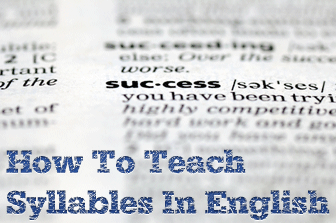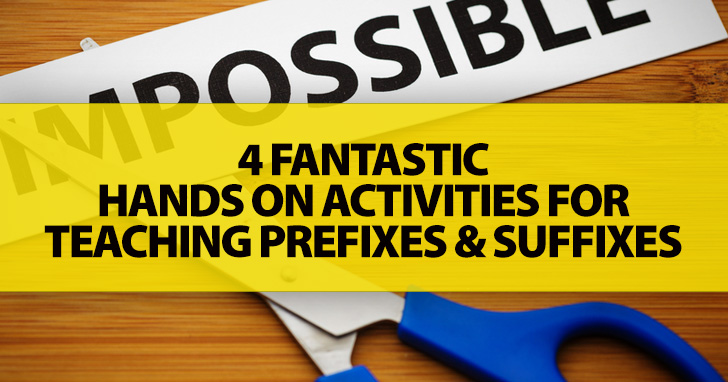The Syllables Have It: Activities You Can Use to Teach Syllables in English


Doing so not only increases their vocabulary, it gives them tools to understand words they have never encountered before. These activities are designed to be hands on ways of teaching and reviewing affixes with ESL students. Like any students, the more they get their hands involved in learning, the better they will remember the information. Not to mention these activities are fun and engaging, too.

This is a simple activity to review affixes which you can do as a class or set up as a learning center in your classroom. Start by typing up a list of words that have both prefixes and suffixes using a large font. They can be words that are either familiar to your students or words that they do not know but you would like them to learn. Give each person a set of the words and a divided paper or Styrofoam plate. (These plates usually have one large section and two smaller sections.) Students should label the large section “roots” and the smaller sections “prefixes” and “suffixes”. Have students separate the words from each other. Either as a class or individually, students should then look at each word and determine what prefix(es) and suffix(es) the word contains. Once they have decided, they should cut off each prefix and put it in the right section of the plate and cut off each suffix and put it in the right section of the plate. The roots go in the largest section. As you do the activity, talk about the meaning of each affix and root word. When all the words have been divided, encourage students to rearrange the pieces to make new words with both prefixes and suffixes.
If you are teaching prefixes and suffixes in the spring, this combined art project and affix review might be just right for your students. In this activity, students will build a flower garden using root words and affixes. Start by giving each student a large piece of white paper and some green strips of paper to use as flower stems. On each stem, students should write a root word. They will then add a prefix and suffix to each word root. To add a prefix, students should cut a flower shape out of a colored piece of paper, write the prefix on it, and then glue it to a stem. To add a suffix, students should cut out a leaf, write the suffix on it, and then glue it to the stem. When a flower is complete, it will have a prefix flower, root word stem, and suffix leaf. You can also make this activity into an independent practice activity for students. Rather than gluing their flowers together, have students carefully place their flower parts on their paper. Once all the flowers are complete, they should collect all the pieces and put them in a zip top bag. Students can then exchange bags with a classmate and race to see who can put the flowers together correctly fastest. This is a good activity for your students to use dictionaries in class as well, especially if they are struggling to think of words with prefixes and suffixes.
Have you realized the value of using paint samples in your ESL class? They are free, pretty, and sturdy, and they are one of the most versatile materials you can use when teaching language. To use these simple color cards to teach affixes, you will need paint samples with at least three different colors on the card, clothes pins, and some time to get the materials set up. Grab two of each color sample for every one or two students in your class. One will remain intact and will be the building area for a word. The other one you will cut into squares (or use a circle hole punch in you have one the right size). For each word, write one piece of the word on one of your square cut outs – prefix, root, and suffix. Make sure you keep your cutouts in the same order as they appear on the card. (For example, the prefix would be on the darkest color, the root on the middle color, and the suffix on the lightest color on the card.) Then glue each cutout to a clothes pin. Do the same for each word you want your students to practice.
To use the materials in class, “shuffle” the clothes pins and pin them around the edge of a small bucket or container. Put the intact paint samples inside the bucket. Students work by themselves or with a partner to build all the words from the pieces on the clothes pins. They take turns taking a clothes pin from the bucket and placing in on the correct location on the paint sample. When they have completed a word, the three colors on the sample will each have a clothes pin clipped to it. Those clothes pins together will make one complete word – prefix, root, and suffix. As you do the activity, remind your students that prefixes come at the beginning of a word and suffixes come at the end of a word. This activity is especially good for students just learning affixes since they will have the assistance of the colors to help them build their words correctly. Once your students have mastered this activity, ask them to sort the clothes pins into categories: prefixes, roots, and suffixes. See if they can combine them in different orders to make new words.
This game is simple to play, and it can review prefixes, suffixes, or both. On a blank die, write six prefixes (or suffixes or some of each). Have students work in pairs for the activity. Have students roll the die (if you have one for each pair in class) or roll it yourself (if you want the whole class to do the activity at one time). For the prefix that comes up, students take turns giving a word which starts with that prefix. Students keep giving words until someone cannot think of another word. The last person to give a word scores a point. The first person to score four points, wins the game.
I love bringing hands on activities into my classroom. My students get excited and involved in the activities we are doing, and I know they are learning and remembering the information they are working with. When you are ready to teach prefixes and suffixes to your ESL class, try one of these activities and see if you don’t get the same results.
What are the results?